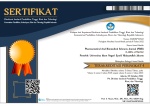Pemantauan Kadar Obat Antiepilepsi dalam Darah terhadap Clinical Outcome pada Pasien Epilepsi di RSPAD Gatot Soebroto dengan Pendekatan Farmakokinetika
Abstract
The use of antiepileptic drugs requires monitoring of blood drug levels because antiepileptics are drugs with a narrow therapeutic index. This study was conducted to determine the relationship between the accuracy of blood antiepileptic drug levels and clinical outcomes in epilepsy patients at RSPAD Gatot Soebroto using a pharmacokinetic approach. This study is an analytical observational study with a retrospective cross-sectional study of epilepsy patients using antiepileptic drugs from January 2023 to January 2024 at RSPAD Gatot Soebroto Jakarta. The results of this study showed that the most antiepileptic drug was valproic acid (38.55%). Of the 32 patients using valproic acid, there were 22 uses of valproic acid below the therapeutic range (<50 mg/L), 10 uses of valproic acid within the therapeutic range (50–100 mg/L). Of the 22 uses of phenytoin, there were 4 uses of phenytoin below the therapeutic range (<10 mg/L), 17 uses of phenytoin within the therapeutic range (10–20 mg/L), and 1 use of phenytoin above the therapeutic range (>20 mg/L). Of the 10 uses of carbamazepine, 1 use of carbamazepine was below the therapeutic range (<4 mg/L), and 9 uses of carbamazepine were within the therapeutic range (4-12 mg/L). Of the 4 uses of levetiracetam, there were 4 uses of levetiracetam below the therapeutic range (12-46 mg/L), and 1 use of oxcarbazepine had a therapeutic range below the therapeutic range (3-35 mg/L). In clinical outcomes within 6 months, 18.07% of patients experienced seizures after receiving antiepileptic drug therapy, and 81.93% of patients experienced seizure-free for up to 6 months. The conclusion of this study is that a p-value of >0.05 is obtained, which means that there is no relationship between clinical outcomes and the accuracy of antiepileptic drug levels in the blood of epilepsy patients. This is because there are other pharmacokinetic parameters that cannot be predicted, so it is necessary to monitor antiepileptic drug levels directly on patients to improve the desired clinical outcomes.
Keywords
References
Agustin, O. A., & Fitrianingsih, F. (2021). Kajian Interaksi Obat Berdasarkan Kategori Signifikansi Klinis terhadap Pola Peresepan Pasien Rawat Jalan di Apotek X Jambi. Electronic Journal Scientific of Environmental Health And Disease, 1(1), 1–10. https://doi.org/10.22437/esehad.v1i1.10759
Agustina, S., Widjaja, J. S., & Puspasari, R. (2022). Penggunaan Asam Valproat pada Pasien Epilepsi di Poliklinik Saraf Rumah Sakit Tingkat III Brawijaya Surabaya Periode Maret-Agustus 2021. Cermin Dunia Kedokteran,49(3),126–128. https://doi.org/10.55175/cdk.v49i3.203
Amelia, K., Rusli, D., & Wandira, A. (2023). Pemantauan Kadar Fenitoin Melalui Estimasi Kadar Obat Dalam Darah pada Pasien Rawat Jalan di RSUD Sekayu Periode Januari-Desember 2022. Jurnal Ilmiah Bakti Farmasi,8(1),9–16. https://doi.org/10.61685/jibf.v8i1.96
Apsari, R. K. F., Rahardjo, S., & Prayunanto, E. (2018). Manajemen Anestesi pada Epilepsi. Jurnal Komplikasi Anestesi,5(2),73–80. https://doi.org/10.22146/jka.v5i2.7326
Aswir, & Misbah, H. (2018). Studi Rasionalitas Penggunaan Obat Antiepilepsi Pada pasien Dewasa Epilepsi di Rawat Inap RSUD Dr. Saiful Anwar Kota Malang Periode 2017. Universitas Islam Negeri Maulana Malik Ibrahim. Available at: http://etheses.uin-malang.ac.id/id/eprint/13616
Behr, C., Goltzene, M.A., Kosmalski, G., Hirsch, E., & Ryvlin, P. (2016). Epidemiology of epilepsy. Revue neurologique, 172(1),27-36. https://doi.org/10.1016/j.neurol.2015.11.003
Beringer, P. (2023). Winter's Basic Clinical Pharmacokinetics. 7th edn. Lippincott Williams & Wilkins.
Dewi, N. P. (2020). Analisis Pola Penggunaan Obat Anti Epilepsi di Instalasi Rawat Inap Rumah Sakit Umum Daerah Madani Provinsi Sulawesi Tengah. Jurnal Farmasi Muhammadiyah Kuningan, 5(1), 12–18.
Hasibuan, M. H., Mahama, C. N., & Tumewah, R. (2016). Profil penyandang epilepsi di Poliklinik Saraf RSUP Prof. Dr. R.D. Kandou Manado periode Juli 2015 – Juni 2016. E-CliniC,4(2),472–476. https://doi.org/10.35790/ecl.v4i2.14373
Hu, Y., Shan, Y., Du, Q., Ding, Y., Shen, C., Wang, S., Ding, M., & Xu, Y. (2021). Gender and Socioeconomic Disparities in Global Burden of Epilepsy: An Analysis of Time Trends From 1990 to 2017. Frontiers in Neurology,12(April),1–10. https://doi.org/10.3389/fneur.2021.643450
Jacob, S., & Nair, A. B. (2016). An Updated Overview on Therapeutic Drug Monitoring of Recent Antiepileptic Drugs. In Drugs in R and D (Vol. 16, Issue 4, pp. 303–316). Springer International Publishing. https://doi.org/10.1007/s40268-016-0148-6
Johannessen, S.I., & Tomson, T. (2006) Pharmacokinetic Variability of Newer Antiepileptic Drugs. Clin Pharmacokinet, 45(11),1061–1075. https://doi.org/10.2165/00003088-200645110-00002
Khairani, A. F., & Sejahtera, D. P. (2019). Strategi pengobatan epilepsi : monoterapi dan politerapi. Berkala NeuroSains,18(3),115–119. https://doi.org/10.22146/bns.v18i3.55017
Khansa, A. N., Laksmi Dewi, D. R., & Ilmiawan, M. I. (2022). Hubungan Usia Onset dengan Fungsi Kognitif Pasien Epilepsi di RSUD dr. Soedarso Kota Pontianak, Indonesia. Cermin Dunia Kedokteran, 49(11), 604–609. https://doi.org/10.55175/cdk.v49i11.313
Lestari, N. D., Hatuti, S., & Astini, N. (2023). Hubungan Lama Pengobatan Dan Jenis Obat Antiepilepsi Dengan Efek Samping Obat Pada Pasien Epilepsi Di Poliklinik Neurologi RSUDZA. Journal of Medical Science, 3(2), 80–87. https://doi.org/10.55572/jms.v3i2.98
Lingga, H. N., Hakim, L., & Pramantara, I. D. P. (2013). Evaluasi Dosis Asam Valproat Pada Pasien Epilepsi Anak.Universita Gajah Mada. Available at : https://etd.repository.ugm.ac.id/penelitian/detail/62895
Nugraha, B., Rahimah, S. B., & Nurimaba, N. (2021). Gambaran Karakteristik Pasien Epilepsi di Rumah Sakit Al-Ihsan Tahun 2018-2019. Prosiding Pedidikan Kedokteran, Vol 7, No, 482–489.
http://dx.doi.org/10.29313/kedokteran.v7i1.26703
Parfati, N., Purnamayanti, A. (2018). Profil Fenitoin Dan Valproat Pada Terapi Epilepsi. Fakultas Farmasi Universitas Surbaya.
Permana, H., & Hardi, E. R. (2021). Perbandingan Tingkat Kepatuhan Pengobatan Pasien Epilepsi antara Monoterapi dan Politerapi di Poliklinik Saraf RSUP Dr. M. Djamil Padang. Health and Medical Journal, 3(2), 14–19.
Perucca E. Is there a role for therapeutic drug monitoring of new anticonvulsants?. (2000). Clin Pharmacokinet, 38(3),191–204. http://dx.doi.org/10.2165/00003088-200038030-00001.
Rahmatullah, S.W., Hakim, L., Pramantara I. D. P. (2015). Estimated Levels Of Phenytoin In Blood And Results Therapy Of Epilepsy Patients. Jurnal Manajemen dan Pelayanan Farmasi (Journal of Management and Pharmacy Practice), 3(2), 132-136. https://doi.org/10.22146/jmpf.111
Suryoputri, M. W., Mustikaningtias, I., & Maharani, L. (2020). Pemantauan Kadar Obat Indeks Terapi Sempit Melalui Estimasi Kadar Obat di Dalam Darah pada Pasien Rawat Inap di RSUD Prof. Dr. Margono Soekarjo, Purwokerto. Indonesian Journal of Clinical Pharmacy, 9(2), 105-117.
Umami, D. A. (2019). Hubungan Media Pembelajaran Dan Minat Terhadap Motivasi Mahasiswi Tingkat Iiikebidanan Widya Karsa Jayakarta. Journal Of Midwifery,7(1),616. https://doi.org/10.37676/jm.v7i1.766
WHO. (2024). Global Epilepsy Report 2024. World Health Organization, Geneva.
DOI: 10.15408/pbsj.v6i2.38924
Refbacks
- There are currently no refbacks.






